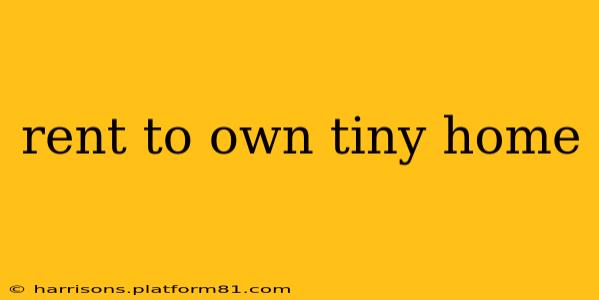The dream of owning a home, especially in today's challenging real estate market, can feel distant for many. However, innovative housing solutions like rent-to-own tiny homes are emerging as viable alternatives, offering a pathway to homeownership for those who might otherwise struggle to afford a traditional mortgage. This comprehensive guide explores the ins and outs of rent-to-own tiny homes, addressing common questions and providing valuable insights for potential buyers.
What is a Rent-to-Own Tiny Home?
A rent-to-own tiny home arrangement allows you to rent a tiny home with an option to purchase it at a predetermined price after a set period. This differs from a traditional lease; a portion of your monthly rent goes towards the eventual purchase price. Think of it as a long-term lease with built-in savings toward homeownership. The specific terms—like the length of the rental agreement, the purchase price, and the amount applied toward the purchase—are all negotiated and outlined in a legally binding contract.
How Does a Rent-to-Own Tiny Home Agreement Work?
Rent-to-own agreements for tiny homes operate similarly to those for larger properties, but with some key differences. Typically, you'll make a down payment upfront, representing a significant commitment. Then, your monthly rent includes both rent payments and an amount applied toward the purchase price, essentially allowing you to pay off the home gradually. The contract specifies the purchase price, the length of the agreement, and the amount allocated to the principal. It's crucial to meticulously review this contract with legal counsel before signing.
Are There Different Types of Rent-to-Own Tiny Homes?
Yes, the specifics of rent-to-own arrangements can vary considerably. Some agreements involve renting a pre-existing tiny home, while others might involve partnering with a builder to construct a custom tiny home specifically for the rent-to-own program. The level of customization, the condition of the home (if pre-existing), and the terms of the agreement will affect the overall cost and suitability for your circumstances.
What are the Pros and Cons of Rent-to-Own Tiny Homes?
Pros:
- Accessibility: Rent-to-own offers a more accessible route to homeownership, particularly for those with limited savings or credit challenges.
- Affordability: Tiny homes generally have lower purchase prices compared to traditional houses, reducing the overall financial burden.
- Building Equity: A portion of your monthly payment directly builds equity, unlike a traditional rental where your money is simply spent on rent.
Cons:
- Higher initial costs: The upfront down payment can still be significant.
- Potential for loss: If you fail to meet the terms of the contract, you could lose your down payment and accumulated equity.
- Limited customization: Depending on the agreement, you might have limited control over the customization of the tiny home.
What are the Potential Risks Involved in Rent-to-Own Agreements?
The biggest risk is losing your down payment and accumulated equity if you default on the agreement. It's crucial to ensure you fully understand the terms and conditions before committing. Unexpected repairs or maintenance costs could also strain your finances. Always have a thorough inspection conducted before signing any contract.
How Do I Find a Rent-to-Own Tiny Home?
Finding a rent-to-own tiny home requires diligent research. Online marketplaces, local real estate agents specializing in alternative housing, and tiny home communities can be good starting points. Networking with others interested in tiny home living can also lead to opportunities.
What are the Legal Considerations of a Rent-to-Own Tiny Home Agreement?
Thoroughly review the contract with a lawyer specialized in real estate transactions before signing. Understand all the terms, conditions, and potential risks. Clarify any ambiguities and ensure the agreement is fair and protects your rights. This is a crucial step to avoid future disputes.
What is the typical length of a rent-to-own agreement for tiny homes?
The length of a rent-to-own agreement for tiny homes can vary significantly, depending on the terms negotiated between the buyer and seller. However, it is typically between 3-5 years, although longer or shorter agreements are also possible.
How much does it cost to rent-to-own a tiny home?
The cost of rent-to-own for a tiny home depends heavily on location, size, and condition of the home. Monthly payments can vary greatly, as will the initial down payment and the total purchase price.
This guide offers a comprehensive overview of rent-to-own tiny homes. Remember that thorough research, careful planning, and professional legal counsel are paramount to a successful and rewarding experience. This emerging market offers exciting possibilities for those seeking affordable and sustainable homeownership.
